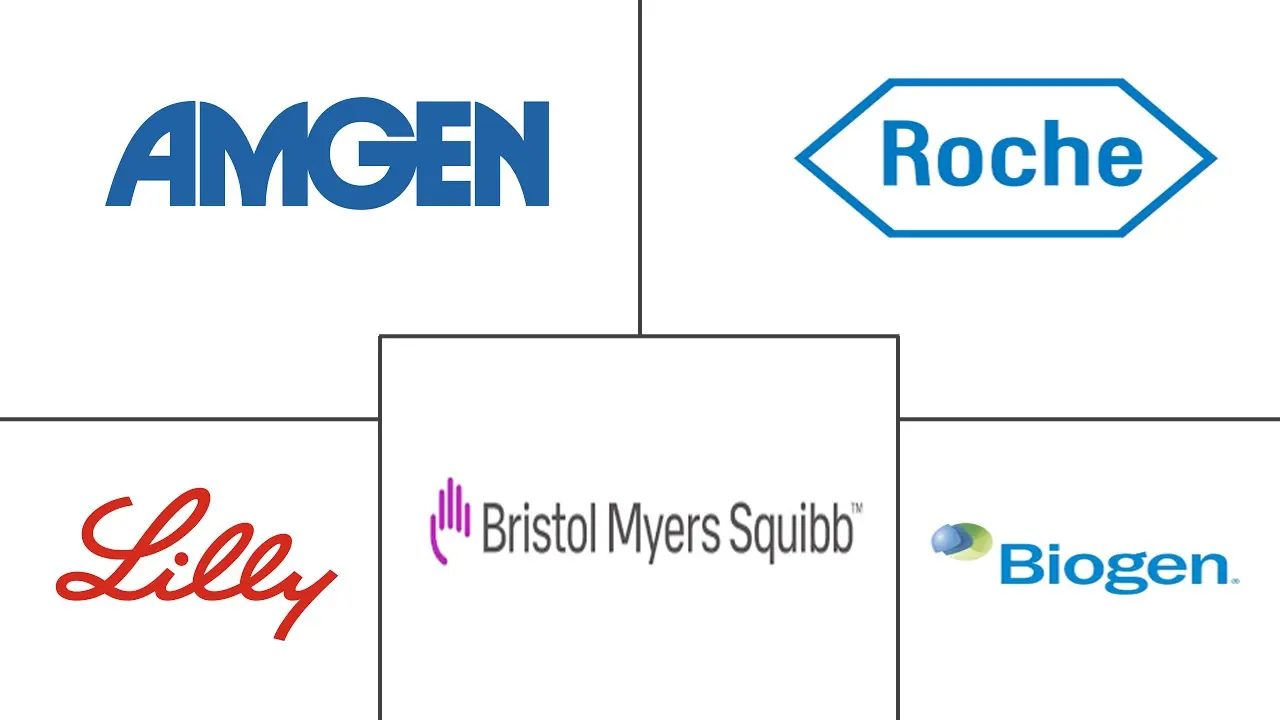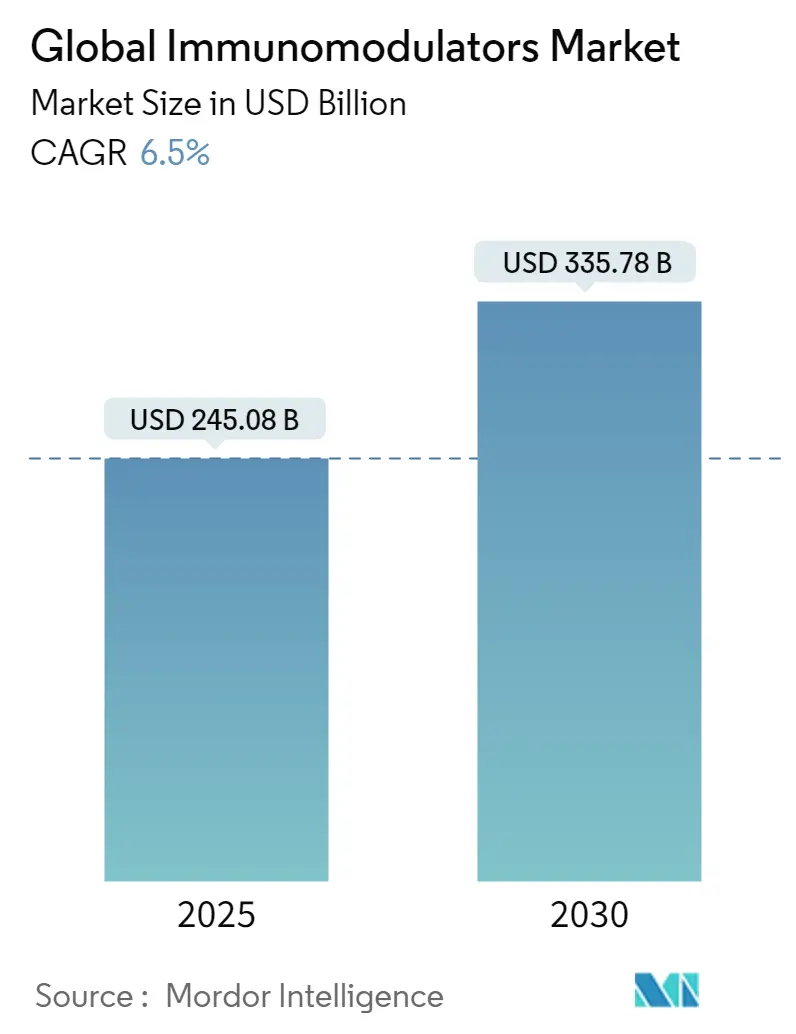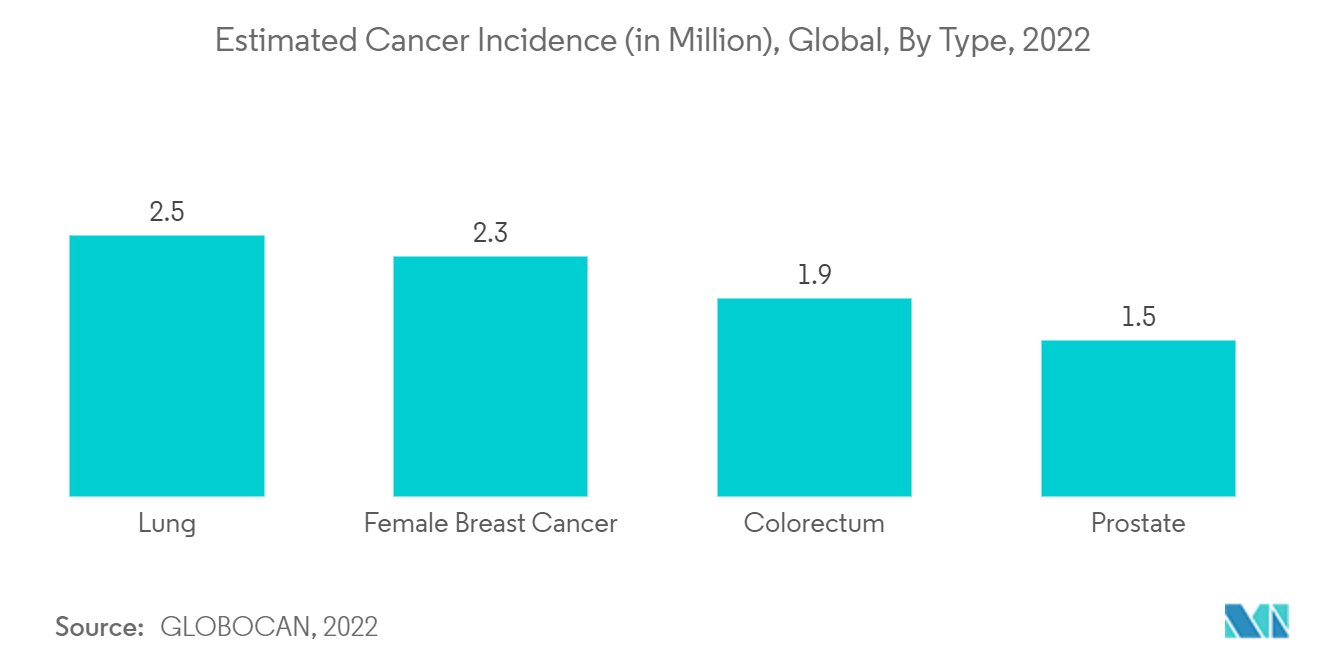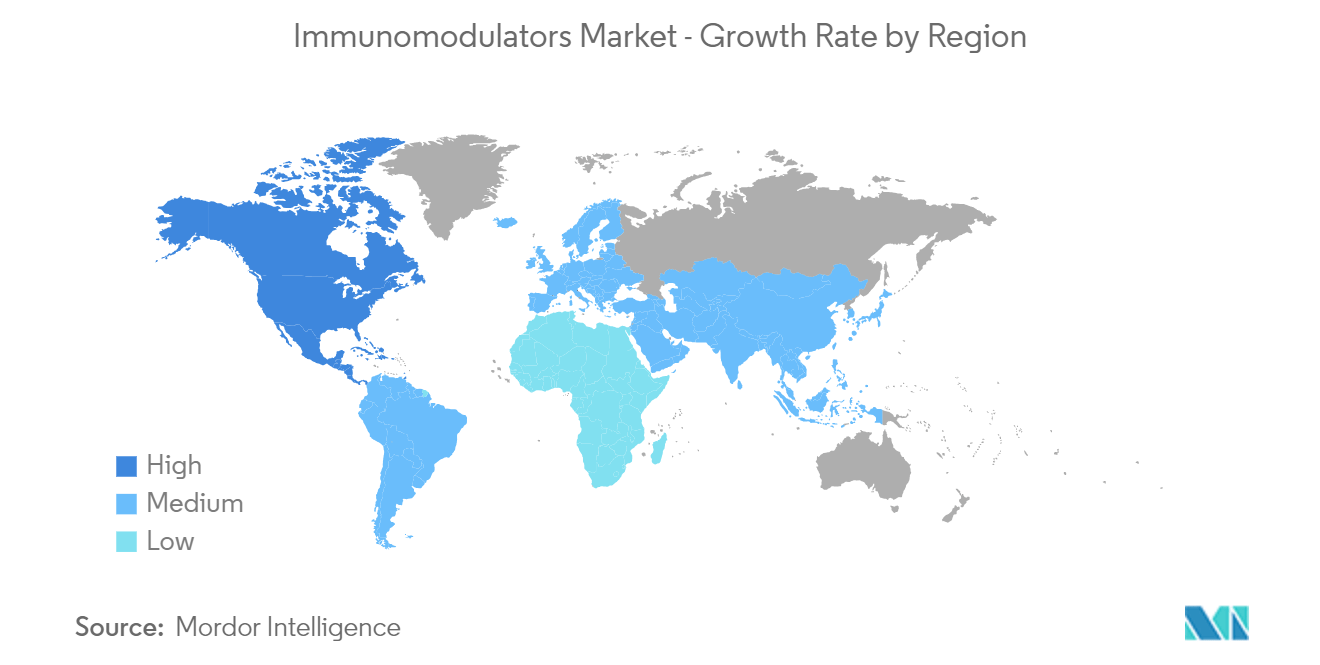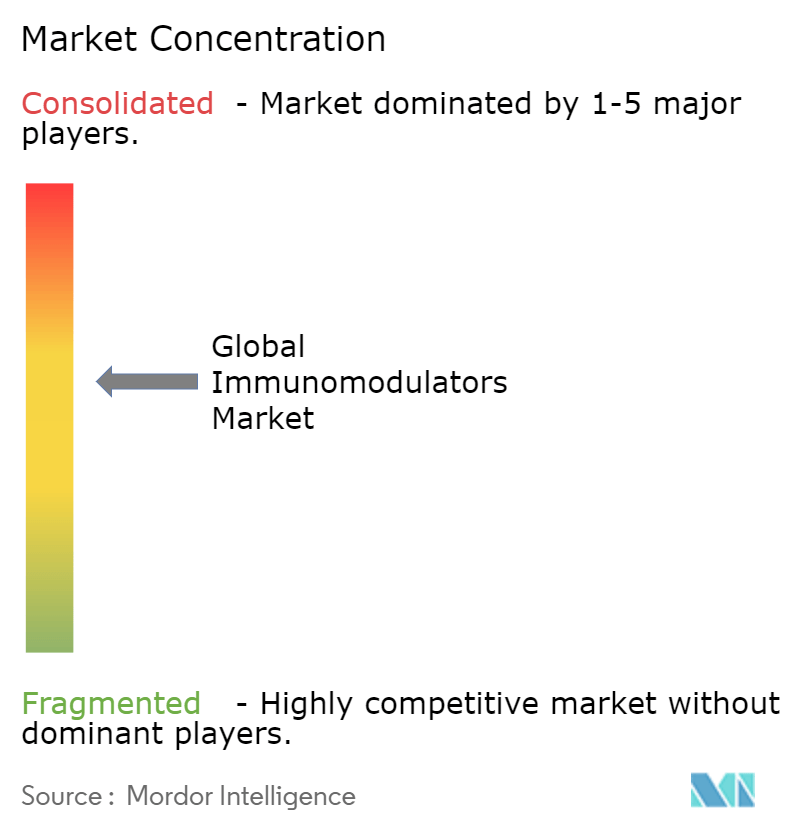Immunomodulators Market Analysis
The Global Immunomodulators Market size is estimated at USD 245.08 billion in 2025, and is expected to reach USD 335.78 billion by 2030, at a CAGR of 6.5% during the forecast period (2025-2030).
Immunomodulators play a pivotal role in contemporary pharmacotherapy, designed to adjust or enhance the immune system's response. These drugs are crucial for addressing a range of conditions, including autoimmune disorders, cancers, and infectious diseases. Recently, the global market for immunomodulators has expanded significantly, fueled by the increasing prevalence of chronic diseases, breakthroughs in biopharmaceutical technologies, and a heightened demand for targeted and personalized therapies. For instance, the American Cancer Society's "Cancer Facts and Figures 2023," published in January 2023, forecasts approximately 1.9 million new cancer diagnoses in 2023. Specifically, prostate cancer cases are projected at 288,300, lung cancer at 238,340, and female breast cancer at 300,590. Given this rising cancer burden, a surge in demand for advanced cancer treatments is expected, likely propelling the immunomodulators market during the forecast period.
The rising prevalence of autoimmune diseases further fuels the growth of the immunomodulators market. Autoimmune disorders, where the immune system mistakenly attacks healthy tissues, are becoming more common. The National Institutes of Health (NIH) estimates that around 24 million people in the U.S. are affected each year. Researchers are actively exploring new immunomodulators for managing these diseases. A November 2023 observational study in the Journal of Internal Medicine by Karolinska Institutet highlights that anti-rheumatic drugs, usually for rheumatoid arthritis, might also help prevent autoimmune thyroid disease. Their research shows that patients with rheumatoid arthritis (RA) have a lower risk of developing autoimmune thyroid disease post-RA diagnosis than before.
Moreover, leading companies are increasingly partnering to innovate products like low-dose CTLA-4 inhibitors and other immune checkpoint inhibitors, such as IDO-1, LAG-3, TIM-3, and CD47/SIRPα agents. These collaborative efforts are set to enhance market revenue in the near future. For instance, GSK's anti-TIM-3 antibody, having successfully passed mid-phase criteria, advanced to a pivotal trial in October 2022 for non-small cell lung cancer (NSCLC).
Nonetheless, the immunomodulators market grapples with challenges like stringent regulatory demands and steep development costs, which can stifle innovation and hinder market entry. Furthermore, the rise of biologics and biosimilars intensifies pricing pressures, complicating the market landscape.
Immunomodulators Market Trends
Oncology is Expected to Hold Significant Market Share in the Application Segment Over the Forecast Period
Oncology, a specialized branch of medicine, centers on preventing, diagnosing, and treating cancer, which is marked by abnormal cell growth in the body. The American Cancer Society's 2023 update highlights a projection of over 1.9 million new cancer diagnoses in the U.S. this year, based on the identification of over 100 distinct cancer types. This projection excludes basal and squamous cell skin cancers and certain carcinoma in situ cases, especially those of the urinary bladder. Breast cancer stands out, constituting 25% of all cancers diagnosed in women globally, alongside prevalent cancers like colorectal, lung, cervical, and thyroid. Given the expected uptick in cancer cases, the oncology segment is set for expansion.
In the last decade, the oncology segment has seen significant growth, driven by a rising demand for effective cancer treatments and the success of novel therapies in clinical trials. Take checkpoint inhibitors as a prime example: pembrolizumab (Keytruda) and nivolumab (Opdivo) have transformed treatment methodologies across a spectrum of cancers, resulting in enhanced patient outcomes. In April 2022, Bristol Myers Squibb secured approval from the European Commission for Opdivo (nivolumab) in combination with chemotherapy. This endorsement was for a first-line treatment targeting patients with unresectable advanced, recurrent, or metastatic esophageal squamous cell carcinoma, especially those with a tumor cell PD-L1 expression of 1%. Thus, the surging demand for checkpoint inhibitors in cancer management is set to fuel segment growth in the foreseeable future.
Moreover, combination therapy is reshaping the oncology segment of the immunomodulators market. By enhancing the efficacy of cancer treatments and addressing the complex nature of tumor biology, this approach employs two or more therapeutic agents to achieve a synergistic effect, thereby improving patient outcomes. Recognizing that cancer is a collection of diverse conditions rather than a monolithic ailment emphasizes the necessity for innovative treatment strategies targeting multiple pathways simultaneously. For instance, in May 2023, Regeneron Pharmaceuticals, Inc. showcased promising outcomes from three independent cohorts. These cohorts evaluated the investigational combination of the LAG-3 inhibitor fianlimab and the PD-1 inhibitor Libtayo (cemiplimab) in adults with advanced melanoma. The initial clinical trial results underscored the combination's significant and enduring efficacy across diverse clinical scenarios, positively influencing the market's growth.
Additionally, company investments are driving progress in the oncology segment of the immunomodulators market, shaping the future of cancer treatment. With bolstered funding, companies can allocate more resources to research and development (R&D), enabling thorough preclinical studies and clinical trials essential for developing effective immunotherapies. A case in point: in December 2023, Odyssey Therapeutics, a biotech firm specializing in precision immunomodulators and oncology therapies, successfully raised USD 101 million in a Series C funding round. As Odyssey Therapeutics advances, its breakthroughs could herald a transformative evolution in cancer treatment, benefiting patients and enriching the broader healthcare landscape.
Given these dynamics, the oncology segment is poised for substantial growth in the coming years.
North America is Expected to Lead the Immunomodulators Market
Throughout the forecast period, North America is poised to command a substantial market share. This dominance is attributed to a surge in chronic disorders, an aging population, and a heightened preference for immunomodulatory drugs. For instance, data from the Canadian Cancer Society in November 2023 highlighted that in 2023, Canada witnessed approximately 239,100 new cancer diagnoses. Additionally, the data projected that around 45% of Canadians would receive a cancer diagnosis at some point in their lives.
Moreover, the rising prevalence of autoimmune diseases, including lupus, multiple sclerosis, and rheumatoid arthritis, is further propelling the region's growth. As per the National Multiple Sclerosis Society in 2024, the U.S. is home to nearly 1 million individuals battling Multiple Sclerosis (MS). While the majority of MS cases are diagnosed between ages 20 and 50, the disease can onset at any age, with a notable prevalence in women.
North America's advanced healthcare infrastructure facilitates the swift adoption of novel therapies. The region, dominated by leading pharmaceutical companies and research institutions, boasts a competitive landscape that fosters innovation. Regulatory entities, especially the Food and Drug Administration (FDA), uphold rigorous safety and efficacy standards for new immunomodulators, bolstering consumer confidence. For instance, in August 2023, the FDA expedited approval for talquetamab-tgvs (Talvey, Janssen Biotech, Inc.), targeting adults with relapsed or refractory multiple myeloma.
Within North America, the U.S. stands out with the largest market share. Key drivers include heightened awareness for early disease detection, favorable reimbursement policies, robust healthcare spending, and an emphasis on research and development. The U.S. also witnesses a surge in new product launches, bolstered by a strong presence of major players in drug R&D. For example, in January 2022, Cellino Biotech, an autonomous cell therapy manufacturer, raised USD 80 million in a Series A funding round. With ambitions to launch the inaugural autonomous human cell foundry by 2025, Cellino is set on expanding access to stem cell therapies. This growing embrace of stem cell technologies for treatment has attracted global investments, underscoring a focus on pioneering therapies in this arena.
In summary, these factors collectively underscore North America's projected growth trajectory in the coming years.
Immunomodulators Industry Overview
This industry is predicted to witness intense competition over the forecast period owing to the increasing adoption of disruptive strategies amongst market players to sustain themselves in the competition. The strategies include distribution channel enhancement, extensive product development activities, mergers & acquisitions, and collaborative agreements for drug development. Some of the key market players operating in the arena of the immunomodulator industry are F. Hoffmann-La Roche Ltd., Amgen, Inc.; Biogen, Johnson & Johnson, Novartis AG, Bristol-Myers Squibb Company, Merck % Co Inc.., Eli Lilly and Company, Pfizer Inc., and Acrotech Biopharma, LLC Inc among others.
Immunomodulators Market Leaders
-
Pfizer Inc
-
Astellas Pharma Inc.
-
F. Hoffmann-La Roche Ltd.,
-
Biogen
-
Bristol Myers Squibb
- *Disclaimer: Major Players sorted in no particular order
Immunomodulators Market News
- August 2023: The United States Food and Drug Administration (FDA) has granted accelerated approval to talquetamab-tgvs (Talvey), developed by Janssen Biotech, Inc. This approval targets adults with relapsed or refractory multiple myeloma. To qualify, patients must have received at least four prior lines of therapy, which must encompass a proteasome inhibitor, an immunomodulatory agent, and an anti-CD38 monoclonal antibody.
- March 2022: Merck's KEYTRUDA, an anti-PD-1 therapy, has secured FDA approval as a standalone treatment for advanced endometrial carcinoma. This approval is tailored for patients exhibiting microsatellite instability-high (MSI-H) or mismatch repair deficient (dMMR) conditions, determined through an approved diagnostic test. The treatment is designated for patients who have seen disease progression post prior systemic therapy and are ineligible for curative surgery or radiation.
- January 2022: The Food and Drug Administration approved KIMMTRAK (tebentafusp-tebn) from Immunocore for the treatment of unresectable or metastatic uveal melanoma.
Immunomodulators Industry Segmentation
As per the scope of the report, immunomodulators are molecules that influence the pathways regulating the immune system's activity. By modifying immune system activity, immunomodulators effectively reduce the inflammatory response.
The immunomodulators market is segmented into product type, application, end-user, and geography. By product type, the market is bifurcated into immunosuppressants and immunostimulants. By application, the market is segmented into oncology, respiratory, HIV, and others. Based on end-user, the market is segmented into hospital, clinics, and others. By geography the market is segmented into North America, Europe, Asia-Pacific, South America, and Middle East and Africa. The report also offers the market size and forecasts for 17 countries across the region. The report offers the value in USD for the above segments.
| By Product Type | Immunosuppressants | ||
| Immunostimulants | |||
| By Application | Oncology | ||
| Respiratory | |||
| HIV | |||
| Others | |||
| By End-User | Hospitals | ||
| Clinics | |||
| Others | |||
| Geography | North America | United States | |
| Canada | |||
| Mexico | |||
| Europe | Germany | ||
| United Kingdom | |||
| France | |||
| Italy | |||
| Spain | |||
| Rest of Europe | |||
| Asia-Pacific | China | ||
| Japan | |||
| India | |||
| Australia | |||
| South Korea | |||
| Rest of Asia-Pacific | |||
| Middle East and Africa | GCC | ||
| South Africa | |||
| Rest of Middle East and Africa | |||
| South America | Brazil | ||
| Argentina | |||
| Rest of South America | |||
Immunomodulators Market Research FAQs
How big is the Global Immunomodulators Market?
The Global Immunomodulators Market size is expected to reach USD 245.08 billion in 2025 and grow at a CAGR of 6.5% to reach USD 335.78 billion by 2030.
What is the current Global Immunomodulators Market size?
In 2025, the Global Immunomodulators Market size is expected to reach USD 245.08 billion.
Who are the key players in Global Immunomodulators Market?
Pfizer Inc, Astellas Pharma Inc., F. Hoffmann-La Roche Ltd.,, Biogen and Bristol Myers Squibb are the major companies operating in the Global Immunomodulators Market.
Which is the fastest growing region in Global Immunomodulators Market?
Asia-Pacific is estimated to grow at the highest CAGR over the forecast period (2025-2030).
Which region has the biggest share in Global Immunomodulators Market?
In 2025, the North America accounts for the largest market share in Global Immunomodulators Market.
What years does this Global Immunomodulators Market cover, and what was the market size in 2024?
In 2024, the Global Immunomodulators Market size was estimated at USD 229.15 billion. The report covers the Global Immunomodulators Market historical market size for years: 2019, 2020, 2021, 2022, 2023 and 2024. The report also forecasts the Global Immunomodulators Market size for years: 2025, 2026, 2027, 2028, 2029 and 2030.
Our Best Selling Reports
Global Immunomodulators Industry Report
Statistics for the 2025 Global Immunomodulators market share, size and revenue growth rate, created by Mordor Intelligence™ Industry Reports. Global Immunomodulators analysis includes a market forecast outlook for 2025 to 2030 and historical overview. Get a sample of this industry analysis as a free report PDF download.

